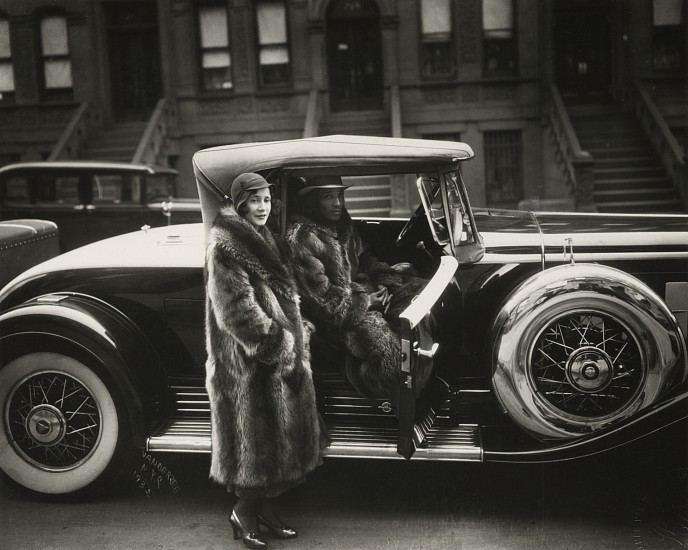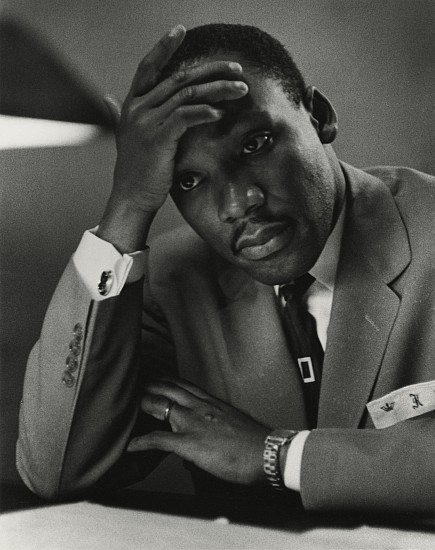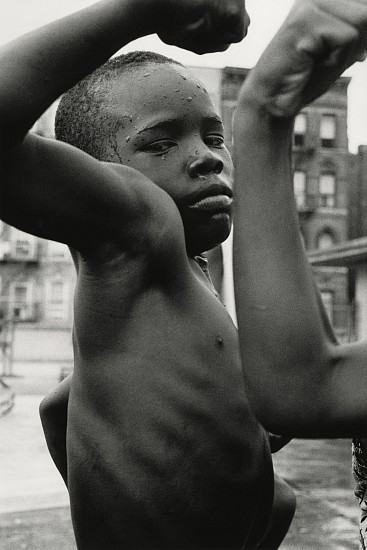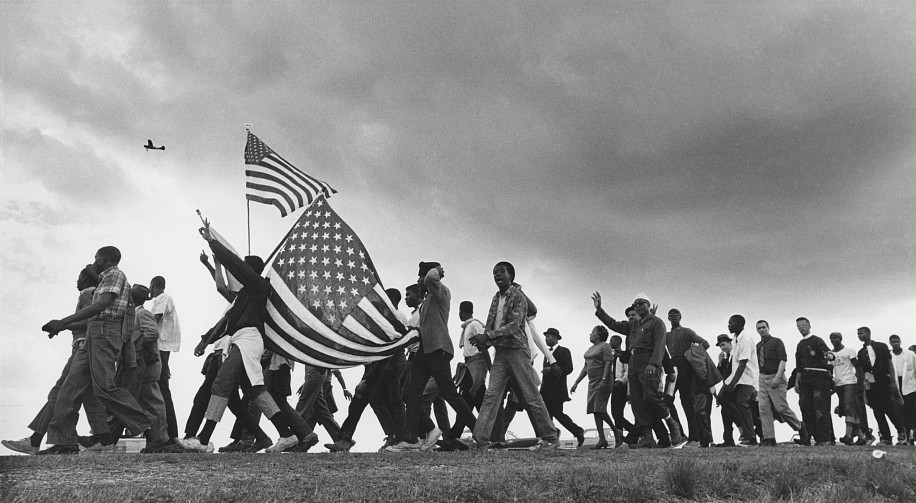February Black History Month Online Exhibition



James Van Der Zee, Couple in Raccoon Coats, 1932
Gelatin silver print; printed later, 7 15/16 x 10 in. (20.2 x 25.4 cm)
8320
Sold
Signed in pencil on window of over mat.
Embossed stamp on print recto in lower right corner of image
Signed and dated by photographer with title, photographer, copyright, print date "1982", edition "41 of 250" and certified with signature of widow Donna Van Der Zee and date "4/1987" in pencil on print verso.
Posed on a residential street in Harlem, New York, this stylish couple is cocooned in signifiers of success: their luxurious automobile, his-and-hers raccoon coats, and serene expressions together create a powerful aura of contentment. Their Cadillac V-16, a top-of-the-line model sold from 1930 to 1940, is the star of the picture. Both expensive and exclusive—only about four thousand were made—each car came with a chassis customized for its owner. The lustrous paint and gleaming chrome of this convertible exemplify the couple’s wealth and security, rarities in the United States during the Great Depression.
Van Der Zee was the most successful portrait photographer working in Harlem in the 1920s and ’30s. During that period, known as the Harlem Renaissance, scores of people settled in this Manhattan neighborhood, which served as a center of black culture in the United States. Here they found like-minded cosmopolitan urbanites who wanted to record their material comforts, social allegiances, and significant life events through photography. While many sitters had their pictures taken in Van Der Zee’s well-accessorized studio, other clients requested that the photographer come to their houses, churches, or schools to document weddings, baptisms, sports leagues, and social organizations. The handsome pair captured here looks wholly at home on West 127th Street. From the shimmer of her shoes to the line of light bouncing off his hat brim, every detail of their image exudes polish and prosperity.
— from MoMA website
Gordon Parks, American Gothic, Washington, D.C., 1942
Gelatin silver print; printed later, 13 1/2 x 9 1/4 in. (34.3 x 23.5 cm)
8324
Unsigned with "230006" in pencil on print verso.
Posed on a residential street in Harlem, New York, this stylish couple is cocooned in signifiers of success: their luxurious automobile, his-and-hers raccoon coats, and serene expressions together create a powerful aura of contentment. Their Cadillac V-16, a top-of-the-line model sold from 1930 to 1940, is the star of the picture. Both expensive and exclusive—only about four thousand were made—each car came with a chassis customized for its owner. The lustrous paint and gleaming chrome of this convertible exemplify the couple’s wealth and security, rarities in the United States during the Great Depression.
Van Der Zee was the most successful portrait photographer working in Harlem in the 1920s and ’30s. During that period, known as the Harlem Renaissance, scores of people settled in this Manhattan neighborhood, which served as a center of black culture in the United States. Here they found like-minded cosmopolitan urbanites who wanted to record their material comforts, social allegiances, and significant life events through photography. While many sitters had their pictures taken in Van Der Zee’s well-accessorized studio, other clients requested that the photographer come to their houses, churches, or schools to document weddings, baptisms, sports leagues, and social organizations. The handsome pair captured here looks wholly at home on West 127th Street. From the shimmer of her shoes to the line of light bouncing off his hat brim, every detail of their image exudes polish and prosperity.
— from MoMA website
Ernest Withers, I am a Man, 1968
Gelatin silver print; printed later, 8 11/16 x 14 13/16 in. (22.1 x 37.6 cm)
8321
Sold
Signed, titled, and editioned 9/35 in pencil on print verso.
Sanitation Workers assemble in front of Clayborn Temple for a solidarity march. "I Am A Man" was the theme for community On the Move for Equality (C.O.M.E.) which spearheaded the Sanitation Strike.
Location: Clayborn Temple, Memphis, Tennessee
Date: March 28, 1968
Dan Weiner, Martin Luther King, Montgomery, Ala., 1956
Gelatin silver print; printed later, 13 5/16 x 10 9/16 in. (33.8 x 26.8 cm)
8322
Photographer's name, title and date in ink on print verso.
(in hand of photographer's widow Sondra Weiner)
Weiner photographed King while on assignment from Collier’s to cover the Montgomery Bus Boycott. Sparked by the arrest of Rosa Parks on 1 December 1955, the Montgomery bus boycott was a 13-month mass protest that ended with the U.S. Supreme Court ruling that segregation on public buses is unconstitutional.
Read on at The Martin Luther King, Jr. Research and Education Institute at Stanford University.
Leonard Freed, Harlem, New York (Muscle Boy), 1963
Gelatin silver print; printed later, 18 x 12 1/16 in. (45.7 x 30.6 cm)
8319
Signed in pencil with photographer's stamp on print verso.
Link to The New York Times obituary of Leonard Freed by Philip Gefter on December 4, 2006.
Matt Herron, The March from Selma to Montgomery, 1965
Gelatin silver print; printed later, 7 1/2 x 13 1/2 in. (19.1 x 34.3 cm)
8323
Sold
Signed, titled and dated in pencil on print verso.
... on March 7, 1965, hundreds of people gathered in Selma, Alabama to march to the capital city of Montgomery. They marched to ensure that African Americans could exercise their constitutional right to vote — even in the face of a segregationist system that wanted to make it impossible.
On the Edmund Pettus Bridge in Selma, state troopers and county members violently attacked the marchers, leaving many of them injured and bloodied — and some of them unconscious.
But the marchers didn't stop. Two days later, Dr. Martin Luther King led roughly 2,500 people back to the Pettus Bridge before turning the marchers around — obeying a court order that prevented them from making the full march.
The third march started on March 21, with protection from 1,000 military policemen and 2,000 Army troops. Thousands of people joined along the way to Montgomery, with roughly 25,000 people entering the capital on the final leg of the march. On March 25, the marchers made it to the entrance of the Alabama State Capitol building, with a petition for Gov. George Wallace.
Only a few months later, Congress passed the Voting Rights Act, which President Lyndon B. Johnson signed into law on August 6, 1965. The Voting Rights Act was designed to eliminate legal barriers at the state and local level that prevented African Americans from exercising their right to vote under the 15th Amendment — after nearly a century of unconstitutional discrimination.
— From the WHITE HOUSE President Barack Obama
ObamaWhiteHouse.Archives.gov












